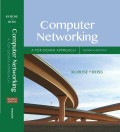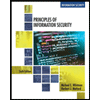
EBK COMPUTER NETWORKING
7th Edition
ISBN: 8220102955479
Author: Ross
Publisher: PEARSON
expand_more
expand_more
format_list_bulleted
Question
Chapter 6, Problem P16P
a.
Program Plan Intro
Figure 6.33:
The “Figure 6.33” contains:
- Two routers.
- Three switches (LAN).
- Three subnets.
- Each subnet contains two host computers.
- Subnet 1 contains two hosts named “A” and “B”. Both the two hosts are connected through a same switch.
- Subnet 2 contains two hosts named “C” and “D”. Both the two hosts are connected through a same switch.
- Subnet 3 contains two hosts named “E” and “F”. Both the two hosts are connected through a same switch.
Given consideration:
Consider that the second router is replaced by a switch.
b.
Program Plan Intro
Figure 6.33:
The “Figure 6.33” contains:
- Two routers.
- Three switches (LAN).
- Three subnets.
- Each subnet contains two host computers.
- Subnet 1 contains two hosts named “A” and “B”. Both the two hosts are connected through a same switch.
- Subnet 2 contains two hosts named “C” and “D”. Both the two hosts are connected through a same switch.
- Subnet 3 contains two hosts named “E” and “F”. Both the two hosts are connected through a same switch.
Given consideration:
Consider that the second router is replaced by a switch.
c.
Program Plan Intro
Figure 6.33:
The “Figure 6.33” contains:
- Two routers.
- Three switches (LAN).
- Three subnets.
- Each subnet contains two host computers.
- Subnet 1 contains two hosts named “A” and “B”. Both the two hosts are connected through a same switch.
- Subnet 2 contains two hosts named “C” and “D”. Both the two hosts are connected through a same switch.
- Subnet 3 contains two hosts named “E” and “F”. Both the two hosts are connected through a same switch.
Given consideration:
Consider that the second router is replaced by a switch.
Expert Solution & Answer
Want to see the full answer?
Check out a sample textbook solution
Students have asked these similar questions
We have 5 routers labled A-E. Suppose we have the forwarding tables shown below after the routingalgorithm is stable. Let all links have cost 1.
a. If a message is originated from A and a destination is E. Which path does it take?b. If a message is originated from C and a destination is D. Which path does it take?c. Give a diagram of a possible network consistent with these tables.
Consider the network shown below, and Dijkstra’s link-state algorithm. Suppose that Dijkstra's algorithm has been run to compute the least cost paths from node E to all other nodes. Now suppose that source node E has a packet to send to destination node A. What is the first router to which E will forward this packet on its path to A?
What objectives does the transit protocol serve? This is an illustration of how the Routing Information Protocol (RIP) operates so that you may observe its operation.
Chapter 6 Solutions
EBK COMPUTER NETWORKING
Ch. 6 - Consider the transportation analogy in Section...Ch. 6 - If all the links in the Internet were to provide...Ch. 6 - Prob. R3RQCh. 6 - Prob. R4RQCh. 6 - Prob. R5RQCh. 6 - Prob. R6RQCh. 6 - Prob. R7RQCh. 6 - Prob. R8RQCh. 6 - Prob. R9RQCh. 6 - Prob. R10RQ
Ch. 6 - Prob. R11RQCh. 6 - Prob. R12RQCh. 6 - Prob. R13RQCh. 6 - Prob. R14RQCh. 6 - Prob. R15RQCh. 6 - Prob. R16RQCh. 6 - Suppose the information content of a packet is the...Ch. 6 - Suppose the information portion of a packet (D in...Ch. 6 - Prob. P4PCh. 6 - Prob. P5PCh. 6 - Prob. P6PCh. 6 - Prob. P7PCh. 6 - Prob. P8PCh. 6 - Prob. P9PCh. 6 - Prob. P10PCh. 6 - Prob. P11PCh. 6 - Prob. P12PCh. 6 - Prob. P13PCh. 6 - Prob. P14PCh. 6 - Prob. P15PCh. 6 - Prob. P16PCh. 6 - Prob. P17PCh. 6 - Prob. P18PCh. 6 - Prob. P19PCh. 6 - Prob. P20PCh. 6 - Prob. P21PCh. 6 - Prob. P22PCh. 6 - Prob. P23PCh. 6 - Prob. P24PCh. 6 - Prob. P25PCh. 6 - Prob. P26PCh. 6 - Prob. P27PCh. 6 - Prob. P32PCh. 6 - Prob. P33P
Knowledge Booster
Similar questions
- QUESTION 77 Consider the network topology shown below with routers labeled A through F, inclusive. Each link is labeled with its "cost" for routing purposes. The link state routing algorithm is used in this network. (a)Show how Djikstra's algorithm works to compute paths from Router E to all other routers (show your answer in a table format similar to the one used in the lectures). (b)Show the final forwarding table at Router E after completion of the algorithm.arrow_forwardQuestion 5: Suppose you attach a network monitor to observe the sequence of frames that travel over a link from sender A to receiver B. The problem is to deduce what protocols, if any, could have generated the observed sequence. The following diagrams depict a flow of frames, with their corresponding sequence numbers, from the sender (A). There may be traffic from B to A, which is not depicted in the diagram. A gap between adjacent frames implies passage of time with no transmission from the sender. Note that the x-axis is time, and not space. Justify your answer. A A A ● ● ● ● 1 5 ● 3 5 0 ● 0 0 1 1 1 ● Go-Back-N ● Selective Repeat 1 0 5 0 c) For Diagram 3, the protocol is not: Stop-and-Wait Time Diagram 1 2 Time a) For Diagram 1, the most likely protocol being used is: Stop-and-Wait ● Go-Back-N (if Go-Back-N, give the window size) Selective Repeat (if Selective Repeat, give the window size) Diagram 2 Time 3 Diagram 3 1 Time b) For Diagram 2, the most likely protocol being used is:…arrow_forwardConsider a router that interconnects three subnets: Subnet 1, Subnet 2, and Subnet 3. Suppose all of the interfaces in each of these three subnets are required to have the prefix 223.1.17/24. Also suppose that Subnet 1 is required to support up to 25 interfaces, Subnet 2 is to support up to 50 interfaces, and Subnet 3 is to support up to 75 interfaces. Provide three network addresses (of the form a.b.c.d/x) that satisfy these constraintsarrow_forward
- Consider a router that interconnects three subnets: Subnet 1, Subnet 2, and Subnet 3. Suppose all of the interfaces in each of these three subnets are required to have the prefix 223.10.128/24. Also suppose that Subnet 1 is required to support at least 50 interfaces, Subnet 2 is to support at least 100 interfaces, and Subnet 3 is to support at least 12 interfaces. Provide three network addresses (of the form a.b.c.d/x) that satisfy these constraints.arrow_forwardThere is confusion over the nature of an overlay network. Could you kindly tell me whether the bundle includes a router? Where precisely do the overlay's limits lie?arrow_forwardConsider a computer 1 that communicates with a computer 2 via LAN1, router R1, and LAN2. The sending computer1 is running two processes at this time with port addresses k and l. The receiving computer 2 is running three processes at this time with port addresses f, g and h. Process k in the sending computer 1 needs to communicate with process g in the receiving computer 2. Draw the network and show the contents of segments, packets and frames at the network, data link, and transport layer for each hop. Note: Computer 1 has: Physical address=15, Logical address=A Router R1 has: Physical address in the side of LAN 1=20, Logical address in the side of LAN1=B Physical address in the side of LAN 2=50, Logical address in the side of LAN2=D. Computer 2 has: Physical address=77, Logical address=E.arrow_forward
- Consider a router that interconnects three subnets: Subnet 1, Subnet 2, and Subnet 3. Suppose all of the interfaces in each of these three subnets are required to have the prefix 223.1.17/24. Also suppose that Subnet 1 is required to support 70 interfaces, Subnet 2 is to support 40 interfaces, and Subnet 3 is to support 40 interfaces. Provide three network addresses (of the form a.b.c.d/x) that satisfy these constraints. Please provide a short discussion justifying your answer.arrow_forwardEach active interface of Distance vector gets frequent transmissions of the whole routing table that Distance vector maintains. The link status protocol broadcasts information about the state of a router's own connections to all other routers in the network. Each statement has two ideal examples that show how the Link state and the Distance vector may be utilized in a number of circumstances.arrow_forwardA router interconnects a subnet, where all the interfaces of the subnets must have the prefix 164.132.62/24. suppose that the Subnet is required to support up to 60 interfaces, provide a network address that satisfies the above.arrow_forward
- 5.03-5. Dijkstra's Algorithm (3, part 5). Consider the network shown below, and Dijkstra's link-state algorithm. Suppose that Dijkstra's algorithm has been run to compute the least cost paths from node E to all other nodes. Now suppose that source node E has a packet to send to destination node A. What is the first router to which E will forward this packet on its path to A? OF (A) 3 2 4 B 8 D 10 4 E 4 2 Farrow_forward21. Consider the network below. a. Show the forwarding table in router A, such that all traffic destined to host H3 is forwarded through interface 3. b. Can you write down a forwarding table in router A, such that all traffic from H1 destined to host H3 is forwarded through interface 3, while all traffic from H2 destined to host H3 is forwarded through interface 4? H1 H2 1 2 3 1 2 2 1 2 H3arrow_forwardConsider a router that interconnects four subnets: Subnet 1, Subnet 2, Subnet 3, and Subnet 4. Suppose all of the interfaces in each of these four subnets are required to have the prefix 223.1.17/24.Also suppose that Subnet 1 is required to support at least 90 interfaces, Subnet 2 is to support at least 60 interfaces, Subnet 3 is to support at least 13 interfaces, and Subnet 4 is to support 2 WAN interfaces. Provide four network addresses (of the form a.b.c.d/x) that satisfy these constraints. Also, justify your answer.arrow_forward
arrow_back_ios
SEE MORE QUESTIONS
arrow_forward_ios
Recommended textbooks for you
 Principles of Information Security (MindTap Cours...Computer ScienceISBN:9781337102063Author:Michael E. Whitman, Herbert J. MattordPublisher:Cengage Learning
Principles of Information Security (MindTap Cours...Computer ScienceISBN:9781337102063Author:Michael E. Whitman, Herbert J. MattordPublisher:Cengage Learning

Principles of Information Security (MindTap Cours...
Computer Science
ISBN:9781337102063
Author:Michael E. Whitman, Herbert J. Mattord
Publisher:Cengage Learning